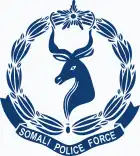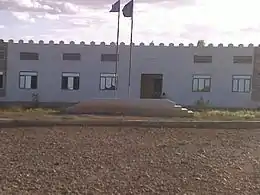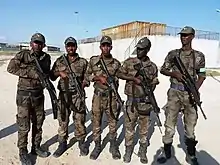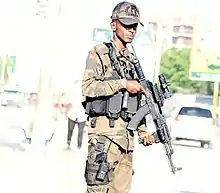Somali Police Force
The Somali Police Force (SPF; Somali: Ciidanka Booliska Soomaaliya (CBS); Arabic: قوة الشرطة الصومالية) is the national police force and the main civil law enforcement agency of Somalia. As with most other police forces in the world, its duties include crime fighting, traffic control, maintaining public safety, counter-terrorism. It is under the jurisdiction of the Minister of Public Security.
| Somali Police Force Ciidanka Booliska Soomaaliya قوة الشرطة الصومالية | |
|---|---|
 Logo of the Somali Police Force | |
| Abbreviation | SPF |
| Motto | Kahortag iyo U adeegid (English: Protect and Serve) |
| Agency overview | |
| Formed | 1960 |
| Preceding agency |
|
| Jurisdictional structure | |
| National agency | Somalia |
| Operations jurisdiction | Somalia |
| Governing body | Government of Somalia |
| General nature | |
| Operational structure | |
| Headquarters | Mogadishu, Somalia |
| Elected officer responsible |
|
| Agency executive |
|
| Divisions | 11
|
| Website | |
| police | |
It served from 1960 to 1991 as one of the principal organs of the Somali Armed Forces and upon reorganisation distanced itself away from the Armed Forces. While organised at a national level, each arm reports to a county police authority, which in turn divides its force by local Police Divisions, headquartered at local police stations; the police force was later reconstituted at the start of the 21st century.
In an emergency, the police can be reached by dialing 888 from any telephone in Somalia.[1]
History
In 1884 the British formed an armed constabulary to police the Somaliland coast.[2] In 1910 the British created the Somaliland Coastal Police, and in 1912 they established the Somaliland Camel Corps to police the interior.[2]
In 1926 the colonial authorities formed the Somaliland Police Force.[2] Commanded by British officers, the force included Somalis in its lower ranks.[2] Armed rural constabulary (XirXiran) supported this force by bringing offenders to court, guarding prisoners, patrolling townships, and accompanying nomadic tribesmen over grazing areas.[2][3]
In 1960, the British Somaliland Somaliland Scouts joined with the (Police Corps of Somalia) (1910–1960) to form a new Somali Police Force, which consisted of about 3,700 men.[2] The authorities also organized approximately 1,000 of the force as the Daraawishta Booliska, a mobile group used to keep peace between warring clans in the interior.[2] Until 1991, the government considered the SPF a part of the armed forces.[2] In its inception in 1960, Mohamed Abshir Muse became the first commander of the police force.
The late President of Somalia Siad Barre was among the senior officers and commanders formed under the colonial forces who led the Somali Police Force and Somali National Army after independence in 1960.
Until its dissolution in 1976, the Ministry of Interior oversaw the Force's national commandant and his central command.[2] After that date, the SPF came under the control of the presidential adviser on security affairs.[2]
Re-establishment

After the collapse of the Barre government and the outbreak of the Somali Civil War in 1991, both the Daraawishta and Birmadka forces essentially ceased to operate.[2]
With the start of the 21st century, a new police force was re-established.[4] The Armo Police Academy, the first such training institute to be built in Somalia for several years, opened on December 20, 2005, at Armo, 100 kilometres south of Bosaso.[5] The SPF also has a Criminal Investigative Division (CID) in Mogadishu.[6]
It is the intent of the SPF to initiate rather quickly a reform process to upgrade its police force with adequately trained and equipped officers and units, capable of providing the full range of basic and specialized police services to the public with transparency, accountability and strictly aligned with human rights and rule of law. Particular attention will be given to the community policing concept and the role of women in the police.
However, such reform cannot be carried out without the substantial support of the international community, as the Somali government does not have yet the sufficient financial means to achieve this objective.
Stig Jarle Hansen argued in 2007 that although the UNDP was financially supported by the governments of the United States and Norway, it repeatedly failed to ensure payment to the Somalia police force that it at the time provided training to. He suggests that this led to a high desertion rate of over 100%, as a majority of unpaid TFG policemen and soldiers abandoned their posts after only a few months before defecting. The UNDP's unsuccessful rule of law project and TFG policies created a situation whereby the soldiers who remained in service then resorted to pillaging and theft to sustain themselves, and squabbled over the little funds that were earmarked for them.[7]
On 17 June 2009, Mogadishu's police chief Colonel Ali Said was killed during an attack on insurgent bases in the capital.[8]
_recieve_new_equipment_donated_by_Japan_07_(7156331390).jpg.webp)
In June 2011, the Somali Police Force was given the responsibility of security in Km 4, Guriga Shaqalaha, Isgoyska Dabka and Makka Almukara road. The police also established posts in all of the Transitional Federal Government-controlled districts of Mogadishu.[9]
Since the Al-Shabaab Islamist militants were forced from the capital in August 2011, the police has been conducting investigations and arrests to firm up on security. Officers are trained locally, with the SPF working closely with the Somali Armed Forces to enforce the law. According to Police Commissioner Maya, the SPF expected to have an independent, fully established and well-equipped force following the end of the transitional period in August 2012.[10] Turkey has also offered to train SPF officials to strengthen the police's enforcement capacity.[11]
The United Nations Secretary General reported on 31 January 2013 that:[12]
The United Nations continued to support the activities of the Somali Police Force, including the formulation of a strategic development plan. UNPOS facilitated the procurement of equipment and furniture for 10 police stations in Mogadishu and police headquarters and provided training to 38 Somali Police Force drivers and 5 fleet managers. UNDP continued to pay police stipends to 5,388 Somali Police Force officers on duty in Mogadishu, Baidoa and Galmudug, courtesy of the Government of Japan and the European Union. A total of 4,463 Somali Police Force officers were registered in Mogadishu using the biometric registration system, completing the registration for the capital.
As of August 2014, the Federal Government of Somalia is engaged in capacity-rebuilding for the SPF, with assistance provided by the U.S. Bureau for International Narcotics and Law Enforcement Affairs, the European Union Training Mission Somalia and the United Nations Mine Action Service.
UNDP continued to disburse stipends for the Somali Police Force until 31 December 2015, through the support of the Government of Japan and the European Union. In January 2015 the responsibility for distributing stipends was given to UNOPS.
Leadership and training
Under the parliamentary regime, police received training and material aid from West Germany, Italy, and the United States.[2] Although the government used the police to counterbalance the Soviet-supported army, no police commander opposed the 1969 army coup.[2]
During the 1970s, German Democratic Republic (East Germany) security advisers assisted the SPF.[2] After relations with the West improved in the late 1970s, West German and Italian advisers again started training police units.[2]
By the late 1970s, the SPF was carrying out an array of missions, including patrol work, traffic management, criminal investigation, intelligence gathering, and counter-insurgency.[2] The elite mobile police groups consisted of the Daraawishta and the Birmadka Booliska (Riot Unit).[2] The Daraawishta, a mobile unit that operated in remote areas and along the frontier, participated in the Ogaden War.[2]
Currently the Darwish are trained, equipped and armed officers, responding to the most serious situations in Mogadishu. It is estimated that a Darwish unit of brigade strength would be needed to respond to emergency requests from federal member states for re-enforcement.
The Birmadka acted as a crack unit for emergency action and provided honor guards for ceremonial functions.[2]
In 1961, the SPF established an air wing, equipped with Cessna light aircraft and one Douglas DC-3.[2] The unit operated from improvised landing fields near remote police posts.[2] The wing provided assistance to field police units and to the Daraawishta through the airlift of supplies and personnel and reconnaissance.[2] During the final days of Barre's regime, the air wing operated two Cessna light aircraft and two DO-28 Skyservants.[2]
Structure
Each of the country's administrative regions had a police commandant; other commissioned officers maintained law and order in the districts.[2] After 1972, the police outside Mogadishu comprised northern and southern group commands, divisional commands (corresponding to the districts), station commands, and police posts.[2] Regional governors and district commissioners commanded regional and district police elements.[2]
Technical and specialized police units included the Tributary Division, the Criminal Investigation Division (CID), the Traffic Division, a Communications Unit, and a Training Unit.[2]
Criminal Investigation Division (CID)
The CID, which operates throughout the country, handled investigations, fingerprinting, criminal records, immigration matters, and passports.[2]
The Criminal Investigation Department is fully part of the Somali Police Force and is essentially present in Mogadishu headquarters with some 180 officers (and 27 in the stations).
The department is headed by a Director and a Deputy, who are assisted in their HQ by the directors of six CID divisions.
Since 2019, the United Nations Office on Drugs and Crime (UNODC) has been assisting the CID to train investigators and establish and support specialized units through the UNODC Criminal Investigation Program for Somalia funded by the United States Department of State Bureau for International Narcotics and Law Enforcement Affairs.[13] The objective of the Program is to enhance the investigation capacity of the Somali Police Force and CID, both at the Federal and Federal Member State level, to investigate serious and organized crime in accordance with international treaty obligations and standards, including the United Nations Convention against Transnational Organized Crime and the Protocols Thereto..[14]
Somalia Coast Guard
.jpg.webp)
The Somali Police Force (SPF) is currently only one of the two institutions which has legal authority for maritime law enforcement, the other being the Navy, up to 200 Nautical miles from the coastline, and has despite all odds tried to maintain its role in that area.
Six long-range patrol vessels (LRPVs) ordered from Atlantic Marine and Offshore Group[15] in July 2013[16] as part of a larger contract to build up the Somali Coast Guard are expected to be delivered by the end of the year. The Atlantic Marine and Offshore Group will build, maintain and operate the coast guard fleet and will develop a coast guard training centre to train coast guard personnel, security officers and shore based support personnel.[16]
In Mogadishu the Atlantic Marine and Offshore Group will establish an operational base, including a ship repair facility.[17]
Six Damen Stan 5009 patrol vessel long-range patrol vessels were ordered for Somalia in 2014.[17] They will be equipped with high-speed off-shore interceptor boats.
The Stan Patrol 5009 vessels are 50 metres long, have maximum speed of 30 knots and 18–26 crewmembers. They feature the innovative axe bow concept which cuts through waves rather than slamming over them for superior seakeeping performance.
Somali Coast Guard operations will be managed in coordination with the Somali Coastguard Directorate.[17]
EOD – explosive ordnance disposal unit
The SPF EOD counts 86 SPF officers in total and has benefited from several recent projects, mainly initiated and delivered by UNMAS.
In April 2014, the Government of Somalia in conjunction with the European Union Training Mission Somalia and the United Nations Mine Action Service trained the first ever Somali Police Explosive Ordnance Disposal teams.[18]
Traffic Police Department
The SPF Traffic Police unit counts 140 officers and performs the for such unit usual tasks as well as the official escorts e.g. with motorcycles.
Traffic officers do operate in conditions that are not to underestimate as they are visible beacons of the authority, against whom Al Shabaab has directed specific threats in the past.
In 1961, the SPF established a Women's Unit. Personnel assigned to this small unit investigated, inspected, and interrogated female offenders and victims.[2] Policewomen also handled cases that involved female juvenile delinquents, ill or abandoned girls, prostitutes, and child beggars.[2]
Service units of the Somali police included the Gaadiidka Booliska (Transport Department) and the Health Service. The Police Custodial Corps served as prison guards.[2] In 1971, the SPF created a fifty-man national Fire Brigade. Initially, the Fire Brigade operated in Mogadishu.[2] Later, however, it expanded its activities into other towns, including Kismayo, Hargeisa, Berbera, Merca, Jowhar and Beledweyne.[2]
Special Operations Police Battalion


This Special Operations Command Battalion known as Ciidanka Haramcad in Somali (Cheetah Unit), was inaugurated in March 2019 after the first company of 120 police cadets of a force that is envisage to number between 600 and 800 men, graduated from the Mountain Commando School and Training Center, in Isparta Turkey in February 2019.
This unit has several responsibilities, to assist the Somali National Army in Counter-Insurgency operations in urban areas of Somalia, as a mobile reserve force, to pacify & police areas captured by the SNA allowing it to focus on its primary mandate in the short term of destroying Al-Shabaab as a fighting force in Somalia.
As well as providing security for critical installations & infrastructure such as the Aden Adde International Airport in Mogadishu, and the Green Zone, as well as providing security to large public gathering's such as football fans during as Somali Football league match.
Personnel and training
Beginning in the early 1970s, police recruits had to be seventeen to twenty-five years of age, of high moral caliber, and physically fit.[2] Upon completion of six months of training at the National Police Academy in Mogadishu, those who passed an examination would serve two years on the force.[2]
After the recruits completed this service, the police could request renewal of their contracts.[2] Officer cadets underwent a nine-month training course that emphasized supervision of police field performance.[2]
_receive_new_equipment_donated_by_Japan_08_(7156335858).jpg.webp)
Daraawishta members, or modern Dervishes, attended a six-month tactical training course.[2] Birmaadka personnel received training in public order and riot control.[2]
Heegan Strategic Police Plan
The overall vision of the Heegan plan is to support Somali Police Force (SPF) in a first time to establish basic police services in all the areas, second to upgrade the as such existing capacity of the SPF throughout the country, through reform, restructuring in a new policing model, with a new legal framework, while rehabilitating the specialized police services to their full operational potential, ensuring now the delivery of complete policing services for the Somali population.
The objective of the Heegan plan is to develop a realistic police plan under the Somali National Development Plan, linked with short, medium and longer-term Rule of Law programmes and in line with the federal vision, taking into account existing Somali and international police plans and projects. It aims at bringing together and prioritizing by urgency, all support provided under multiple instruments.
The Heegan plan should support the SPF to
- Rebuild the field capability of police forces in the reconquered territories and throughout the country, so that police officers get the necessary tools and skills to legally, safely and quickly fulfill their expected normal roles and duties.
- Deploy and establish sufficient police capacity in the reconquered territories, in order to release the military from their temporary role of ensuring security in the villages and towns that have been reconquered.
- Further continue to develop the skills capability of the Somali Police Force throughout the whole country so that officers can reliably undertake the full range of basic and more specialized tasks.
Uniform
The Somali Police Force and the Somali Custodial Corps wear different coloured berets, with police wearing blue berets and the Corps wearing green berets, also the beret pin for the police is silver and generally the beret pin for the Corps is gold. The police deploys several uniforms stylized after those from the armed forces (as the Police was and could be currently considered a branch of the armed forces as they do use woodland camouflage uniforms and have ranks with militaristic names and even has blue accents on the rank badges as opposed to the Army's red). Mainly the standard city police uses blue shirts, blue berets and black trousers and dress shoes with black shoulder boards whilst the Custodial Corps have a more militarised standard uniform with a khaki shirt and trousers with black dress shoes, however green shoulder boards are not generally worn, but are for more formal events like the founding of the armed forces and Independence Day.
Agreements
In February 2014, a visiting delegation from Somalia led by Prime Minister Abdiweli Sheikh Ahmed met in Addis Ababa with Prime Minister of Ethiopia Hailemariam Desalegn to discuss strengthening bilateral relations between the two countries. Hailemariam Desalegn pledged his administration's continued support for the peace and stabilization efforts in Somalia, as well as its preparedness to assist in initiatives aiming to build up the Somali security forces through experience-sharing and training. The meeting concluded with a tripartite memorandum of understanding agreeing to promote partnership and cooperation, including a cooperative agreement to develop the police force.[19]
In August 2014, the Somali and U.S. governments reached an agreement in Washington, D.C. stipulating that the United States would contribute $1.9 million toward security sector reform, development and capacity-building efforts in Somalia. The pact was signed by Finance Minister of Somalia Hussein Abdi Halane, U.S. Special Representative for Somalia James P. McAnulty, and Deputy Assistant Secretary for the Bureau for International Narcotics and Law Enforcement Affairs (INL) Todd Robinson. It is primarily slated to provide support to the Somali National Police Force's Criminal Investigative Division (CID), with an emphasis on implementing policies, practices and procedures that buttress citizen services and human rights. The INL will fund the initiative.[6] The treaty is the second of its kind between the Somali government and INL.[20]
In January 2015, Foreign Affairs Minister of Somalia Abdirahman Duale Beyle and a Turkish delegation signed a bilateral treaty in Mogadishu pertaining to police support.[21]
Equipment
Current police vehicles inventory
Somali Police vehicles have two liveries, white with blue doors and a solid blue colour with Police insignia and 888 displayed.
| Name | Origin | Type | Ref |
|---|---|---|---|
| Suzuki DR 200 | Dual-sport motorcycle | [22] | |
| Ford F150 | Pickup truck | [23] | |
| Toyota Hilux | Pickup truck | [24] | |
| Toyota Land Cruiser | Sport utility vehicle | [25] | |
| Volvo V70 | Station wagon | [26] | |
| Toyota ToyoAce | Prisoner transport vehicle | [27] | |
| Volkswagen Passat | Unmarked police car | [28] | |
| BMW M3 | Unmarked police car | [28] | |
| MAN TGM Firetruck | Fire engine | [24] |
Leadership
Chief of the Somali Police
| Name | Took office | Left office | Note |
|---|---|---|---|
| General Abdi Hasan Awale "Qeybdiid" | |||
| General Ashkir Abdi Faarah ''Jijiile'' | 5 January 1967 | 11 December 1994 | Gobalka Galgaduud |
| General Ali Mohamed Hassan "Ali Madobe" | 30 March 2011 | ||
| General Shariif Sheekhuna Maye[29] | 30 March 2011 | ||
| General Abdihakim Dahir Said "Saacid" | 20 May 2013 | 9 July 2014[30] | |
| General Mohamed Sheikh Ismail[31] | 9 July 2014 | 30 October 2014[32] | |
| General Osman Omar Wehliye | 30 October 2014[32] | 30 April 2015[33] | Interim Police Chief |
| General Mohamed Sheikh Hassan | 30 April 2015[33] | Present |
Commissioners of the Somali Police
| Name | Took office | Left office | Note |
|---|---|---|---|
| General Ali Hassan Mohamed "Looyaan" | 16 March 2011 | Replaced | |
| General Osman Omar Wehliye | 16 March 2011 | 30 October 2014[32] |
The current Somali Federal Police Commissioner appointed in June 2018 is Brigadier General Bashir Abdi Mohamed "AMEERIKO", his is a 32-year Police Force veteran and was previously Director of the Criminal Investigation Department
.
Notes
- "Somali Police Force". pol.gov.so. Retrieved 6 May 2017.
- Metz, Helen Chapin (1993). Somalia : a country study (4th ed.). Washington, D.C.: Federal Research Division, Library of Congress. pp. 214–216. ISBN 0-8444-0775-5. OCLC 27642849.
 This article incorporates text from this source, which is in the public domain.
This article incorporates text from this source, which is in the public domain.{{cite book}}: CS1 maint: postscript (link) - "History « Somali Police Force". pol.gov.so. Retrieved 6 May 2017.
- Martino, John (2013). Worldwide Government Directory with Intergovernmental Organizations 2013. CQ Press. p. 1462. ISBN 978-1452299372.
- "New Police Academy Opens in Somalia". undp.org. Archived from the original on 2011-05-12.
- "Somalia and US signs agreement to support Somali police reforms". Goobjoog. 8 August 2014. Retrieved 8 August 2014.
- Stig Jarle Hansen, Al-Shabaab in Somalia: The History and Ideology of a Militant Islamic Group 2005-12, Hurst & Co., 2013, p. 55.
- "BBC NEWS - Africa - Battle kills Somali police chief". bbc.co.uk.
- "SomaliaReport: Somali Police Take Over AMISOM Bases". somaliareport.com.
- "SomaliaReport: Interview with Mogadishu Police Chief". SomaliaReport.com.
- "ABDULLAH BOZKURT - Unleashing people power in Somalia". TodaysZaman. Archived from the original on 2012-08-08.
- "Report of the Secretary-General on Somalia, S/2013/69, para 28 p.6". United Nations Security Council. 31 January 2013.
- "Media Note: United States Contributes $11.4 Million to Support Somalia's Policing and Justice Efforts | USUNVIE". U.S. Mission to International Organizations in Vienna. 2019-05-22. Retrieved 2020-06-23.
- "UNODC training Somali police force". www.unodc.org. Retrieved 2020-06-23.
- "Home". AtlanticMO.com. Archived from the original on 2017-05-10. Retrieved 6 May 2017.
- "Somali Government signs landmark coastal protection contract • Horseed". HorseedMedia.net. 30 July 2013. Archived from the original on 2016-09-18. Retrieved 6 May 2017.
Instituting a Coast Guard is essential for the establishment of the rule of law within Somali waters and the Exclusive Economic Zone (EEZ). This contract clearly contributes to the stability and economic recovery of Somalia and is supporting the Country's Six Pillar Policy.
- Martin, Guy. "Dutch company on course to deliver vessels to Somali Coast Guard | defenceWeb". defenceweb.co.za. Retrieved 14 September 2016.
- "European Union and UNMAS clear Central Mogadishu of Unexploded Ordnance" (PDF). European Union. Retrieved 19 March 2015.
- "Ethiopia: The Prime Minister of Somalia On a Visit to Ethiopia". Government of Ethiopia. Retrieved 17 February 2014.
- "Department of State and the Government of the Federal Republic of Somalia Sign Agreement to Support Police Reform Efforts". U.S. Department of State. Retrieved 18 April 2015.
- "Press Release: Erdogan's Somalia Visit". Goobjoog. 25 January 2015. Retrieved 29 January 2015.
- "Ciidanka Booliska Soomaaliyeed oo Qalab iyo Gaadiid Lagu Wareejiyey (dhegaysi+sawirro)". Radio Daljir (in Somali). 2017-05-24. Retrieved 2020-07-24.
- "Qatar Oo Dowladda Soomaaliya Ku Wareejisay 30 Gaadhi Oo Ay Ciidamada Booliisku Ku Howlgali Doonaan". Goobjoog News. 2018-02-17. Retrieved 2020-07-24.
- "Imaaraadka Carabta oo Xukuumadda Soomaaliya ugu deeqday gaadiid ay ku jiraan kuwa aysan Xabbaduhu karin (SAWIRRO)". www.hiiraan.com. Retrieved 2020-07-25.
- "Somali police officers use project management skills to improve the success of their operations". EUCAP Somalia. 2020-04-14. Retrieved 2020-07-24.
- "Image of Police cars".
- admin. "Daawo:Midawga Yurub Oo Gawaari ku wareejiyey Taliska Booliska Soomaaliya – Gedo Times". Retrieved 2020-07-24.
- "Talyaaniga oo Somaliya ku wareejiyey Gawaari ay ku xiran yihiin Qalab fududeynayo ka hortaga Qaraxyada". www.universaltvsomali.net. Retrieved 2020-07-24.
- "Somalia forms joint security operations bureau". Hiiraan.com. 2014. Retrieved 6 May 2017.
- "Somalia Fires Security Officials After Mogadishu Attack". Haberler. Retrieved 15 July 2014.
- "Abdiwali Sheekh appoints Osman Gasgas as the Interim Police Chief". Goobjoog. 30 October 2014. Retrieved 31 October 2014.
- "Somalia government appoints new Police Commissioner". SomaliCurrent. 30 April 2015. Archived from the original on 2 May 2015. Retrieved 1 May 2015.
References
- Stig Jarle Hansen, Al-Shabaab in Somalia: The History and Ideology of a Militant Islamic Group 2005–12, Hurst & Co., 2013
Further reading
- Alice Hills (2014) Security Sector or Security Arena? The Evidence from Somalia, International Peacekeeping, 21:2, 165–180, DOI:10.1080/13533312.2014.910400
.jpg.webp)